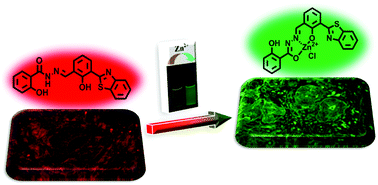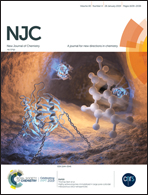An ESIPT based chromogenic and fluorescent ratiometric probe for Zn2+ with imaging in live cells and tissues†
Abstract
A new ESIPT based fluorescent probe has been introduced for selective detection of Zn2+ in human breast cancer cells. The designed probe exhibits a prominent ratiometric fluorescence change along with a sharp blue shift of ∼71 nm which can be attributed to the hampering of the ESIPT process. The probe is efficient enough to detect Zn2+ solely in the presence of other biologically relevant cations with a limit of detection value of 1.6 × 10−7 M. The experimentally observed changes in the structure and absorption properties of the probe after complete addition of Zn2+ were further studied by density functional theory (DFT) and time dependent density functional theory (TDDFT) calculations. Moreover, the dip-stick experiment with this probe displays both absorption and fluorescence color changes after exposure to Zn2+ which also turns out to be a potential application for the probe. Live cell imaging studies have been carried out using human breast cancer cells (MCF-7) and tissues.



 Please wait while we load your content...
Please wait while we load your content...